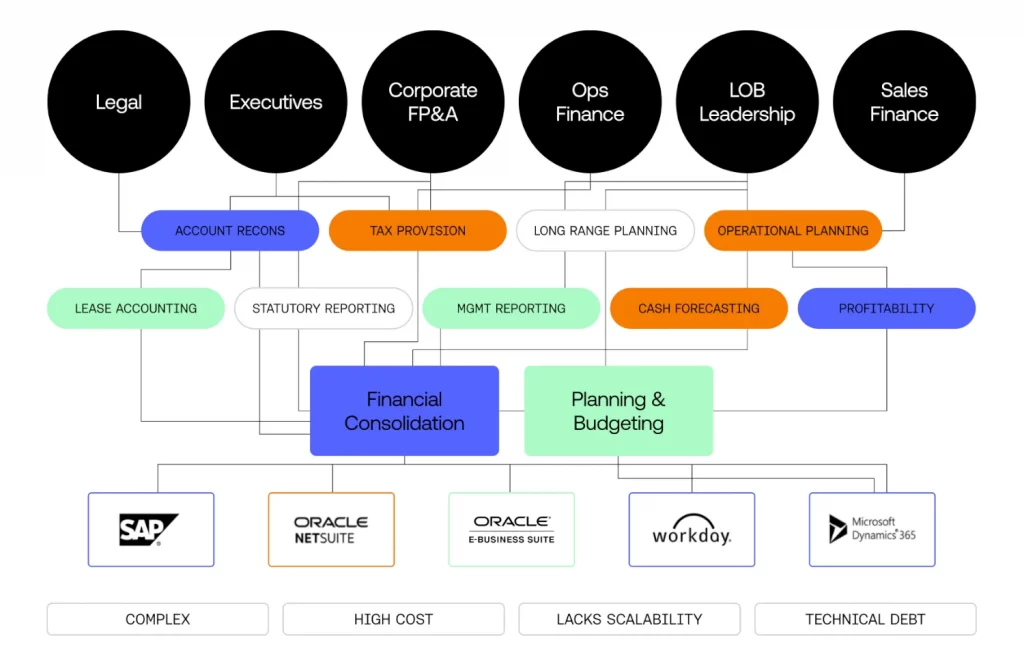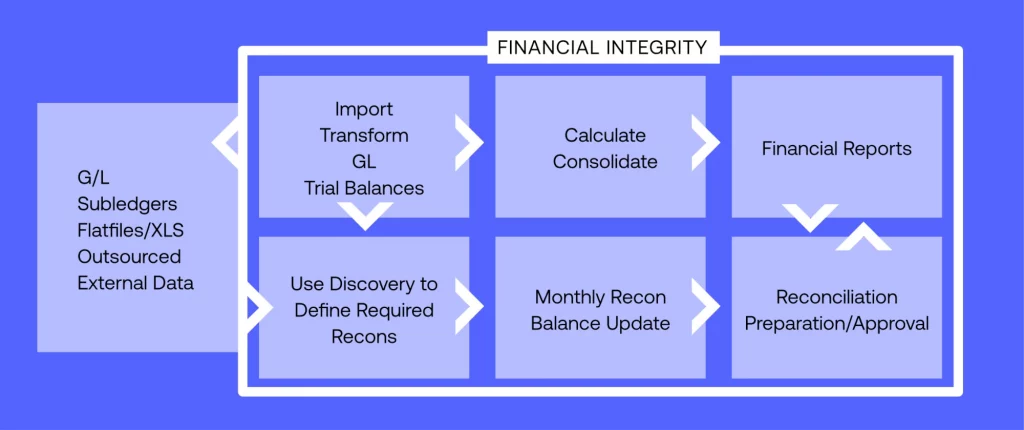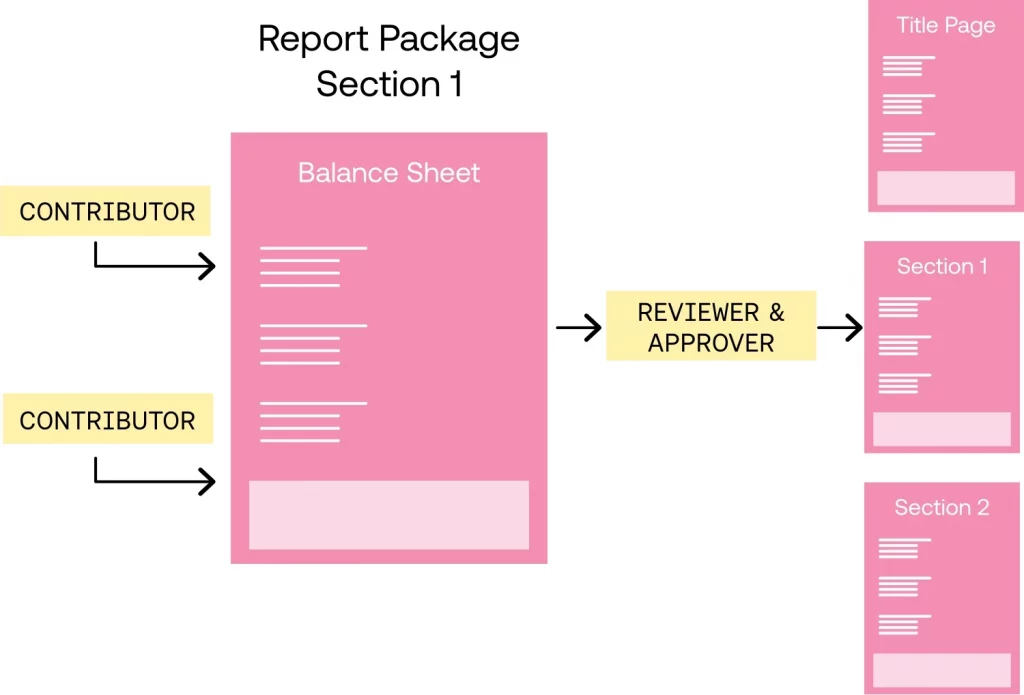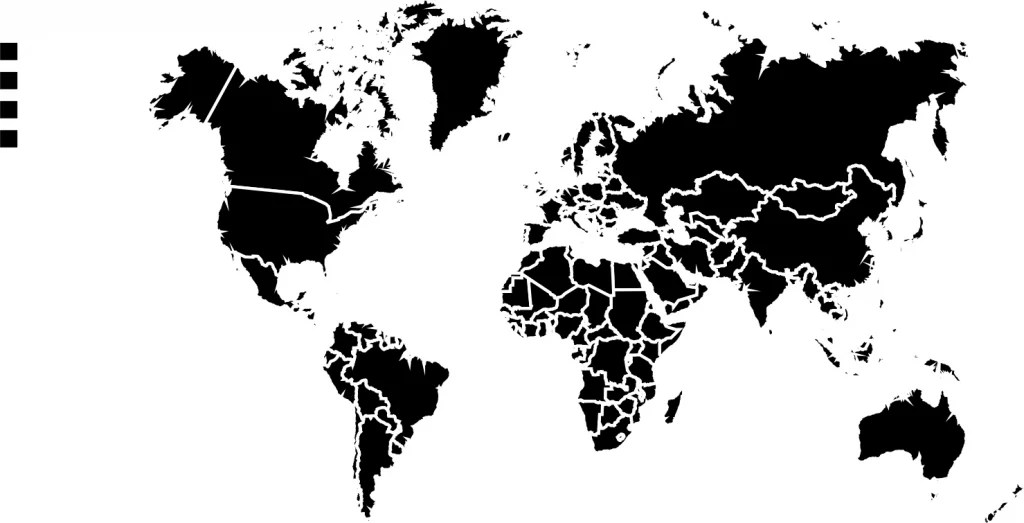For years, the rigidity and inefficiency of disjointed legacy Finance systems has been a reality for Finance organizations. But the unprecedented volatility and rapid pace of change brought about in the 2020s — a pace expected to persist beyond the decade — exposed the importance of an agile Finance team and processes that effectively steer the enterprise through turbulent waters.
Many Finance organizations have transformed specific processes and increased productivity. But conquering the complexity in the financial close will help the Office of the CFO finally tackle the challenges and shortcomings of the traditional month-end close process. In turn, Finance can drive continuous — and controlled — performance throughout the organization.
And with a corporate mission of delivering 100% customer success, OneStream is designed for Intelligent Finance teams with a vision that spans well beyond the numbers.
Why?
To unleash the entire organization with innovations that automate tasks, eliminate low-value processes and reduce risk. To empower the organization with the data-driven insights required to unify decision-making across Sales, Marketing, Operations and Finance. And to inspire the organization to continuously evolve with a digital foundation capable of meeting the challenges of this unprecedented moment in time
In an era where financial precision is no longer a nice to have but rather a requirement, mastering the financial close is a cornerstone for organizations navigating complex economic landscapes. Finance teams today grapple with evolving regulatory requirements, market volatility and growing pressure to use real-time insights. Accordingly, organizations must streamline and optimize the financial close and consolidation processes — a need that has never been more urgent.
Finance professionals looking to take Finance further must therefore leverage innovative technologies and implement best practices to enhance efficiency, accuracy and agility. These demands are especially urgent against the backdrop of current events and the myriad of factors influencing Finance teams within large, complex organizations. Through the transformative potential of mastering the financial close, Finance can not only drive improvements in compliance and strategic decision-making, but also fuel organizational growth.
Complexity and change have and will continue to come at organizations from all angles. For example, Millennials expect much more from employers — more feedback, better internal communication, more flexibility and more benefits, to name a few expectations. Increasing change does, of course, result from ongoing compliance and regulations. And finally, organizations must consider the ongoing changes from new, non-financial data reporting requirements for ongoing risk management and, more recently, Environmental Social & Governance (ESG) reporting.
ESG reporting (a.k.a. sustainability reporting) refers to the disclosure of data covering three areas of organizational operations: environmental, social and corporate governance. In these areas, ESG provides investors, customers and wider stakeholders with a snapshot of the business’s impact. The value of ESG reporting comes from it ensuring organizations consider their impacts on sustainability issues and enabling organizations to be transparent about any risks and opportunities.
57% of executives report having implemented a cross-functional ESG working group.
The constant increase of regulations concerning corporate ESG data reporting makes it increasingly important for organizations to accurately report on those topics. Even though ESG reporting is not yet mandatory in all countries, an increasing number of organizations voluntarily disclose this information. Why? They’ve recognized the importance of communicating their business strategy and how their business impacts the planet.
According to Deloitte, nearly 3 in 5 (57%) executives report having implemented a cross-functional ESG working group tasked with driving strategic attention to ESG. Another 42% report taking steps to do the same as of 2022.
What Might be Holding You Back?
With the introduction of more financial software offerings, we’ve seen the introduction of terms such as the “connected financial close” and “connected reporting” to describe the integration of key Finance processes. These terms emerged in response to increasingly more “modules” coming to market to handle tasks such as account reconciliations, tax provision and financial reporting.
Unfortunately, however, the evolution in many organizations appears to have stopped after the first purchase of a corporate performance management (CPM) solution.
FINANCE PROCESSES AND SYSTEMS ARE OFTEN FRAGMENTED

Connected Finance solutions (see figure 2) have propelled Finance Transformation for over 20 years. Yet these solutions aren’t really designed to help the largest and most complex organizations drive performance in this new era.
For large, global organizations with complex Finance processes, connected Finance solutions are difficult to scale to meet today’s requirements. Why? Because every departmental and corporate application or model must be connected or integrated — adding risk, cost and complexity to already-taxed Finance teams.
Here are some important factors to consider when looking at the current state of the close process within large, complex organizations:
- Fragmented Software & Processes: Connected Finance solutions require fragmented cubes, modules and sometimes third-party software to support critical financial close processes, financial data quality, reporting and analysis. At scale, the constant addition and introduction of new software and processes adds risk, cost and complexity across the Office of Finance.
- More Data Management & Administration: The traditional fragmented software and technical processes needed to support close processes create added technical complexity and administrative burden on the Finance team. This burden includes moving and reconciling data, constantly managing metadata in multiple systems, monitoring data latency and managing security between fragmented products or models. Collectively, the burden dilutes strategic Finance teams’ ability to focus on driving performance and supporting critical decision-making.
- Lack of Critical Financial Close Capabilities: Many connected Finance solutions, particularly for financial consolidation, lack the functionality to deal effectively with complex requirements. Such requirements include consolidating and eliminating inter-company balances automatically without rules, effectively handling alternate hierarchies without duplication of data, or automatically recognizing the calculation/data impacted status. Some even offer no financial intelligence. What does that mean? Essentially, all the core “financial logic” required to support monthly financial processes — such as debit/credit account types, multiple hierarchies, dimensionality and currency translation — must be built completely from scratch.
To truly become a strategic business partner, the Finance function must dramatically reduce its transactional workload. Unleashing the true value of Finance requires efficient processes that minimize manual tasks, such as performing allocations, calculating depreciation or posting manual journal entries. Such efficiency frees up the Finance team to focus on value-added analysis and decision support for the organization.
Automating and unifying the financial close and reporting process ensures faster delivery of financial, operational and sustainability/ESG results to management for accelerated decision-making. Results can also be delivered faster to external stakeholders.

Taking Finance Further
To prosper and thrive in this new world, most organizations have been forced to adapt. And the disruption that the 2020s continues to bring has only accelerated the change. Still, such change was ultimately inevitable for many organizations. More disruption thus exists in markets today, and it occurs at a faster pace compared to the finance department of the past. As technology and methods of investing evolve, challenging traditional business models with something entirely different is faster and easier than ever. Plenty of recent examples exist — such as the advance of the smartphone or the rise of Netflix, Tesla, Airbnb and Uber, to name a few.
Organizations therefore need robust financial close processes to gain information quickly and report to the market with more speed and accuracy than ever before. Accordingly, unnecessary time delays, manual processes, different versions of the truth, and inaccuracies in data and reporting must all become relics of the past. Finance teams can now finally focus on taking the steps needed to lead at speed. And that journey starts with a simple objective.
To take Finance further, Finance teams must overcome the challenges preventing them from being able to move things forward when it is a lot of work just to keep up. Finance must, in other words, get off the treadmill and inally conquer the complexity of disconnected CPM tools and financial close processes.
Amid a steady flow of changes to global reporting regulations over the years, significant parallel shifts have occurred in the technology to support the financial close. These shifts are fueling a desire to perform financial close processes increasingly faster while maintaining and improving the integrity and accuracy of outputs. As a result, the constant change and increasing complexity are driving the need for improved insights and information outside of traditional close cycles. The only effective way to fully deliver this level of data is through a unified and complete financial close process:
- Intercompany
- Account reconciliation
- Financial Statements
- Variance/Flux Analysis
- Task List
- Transaction Matching
- Daily/Weekly Dashboards/Reporting
Let’s Master the Financial Close
A unified financial close solution provides more automation, removes the complexities of the past and meets the diverse requirements of even the most complex organizations, both today and well into the future. For organizations seeking to finally unleash their Finance teams from disconnected tools and spreadsheets, some key capabilities are required. The following capabilities, among others, help take Finance further with the financial close processes:
- Financial data quality
- Anomaly detection
- Account reconciliation & transaction matching
- Financial consolidation
- Financial signaling
- Tax provision
- Built-in reporting & analytics
- Narrative reporting
- ESG/sustainability reporting
FINANCIAL DATA QUALITY
At its core, the fully integrated CPM platform must have good financial data quality management (FDQM). This requirement is critical for organizations to drive effective transformation across Finance and lines of business. A key requirement is 100% visibility from reports to sources. In other words, all financial and operational data must be clearly visible and easily accessible. Key financial processes should be automated. And using a single interface would mean the enterprise can utilize its core financial and operational data with full integration to all ERPs and other systems.
The solution must also include guided workflows to protect business users from complexity. How? By guiding them uniquely through all data management, verification, analysis, certification and locking processes.
At every step in the workflow, users should be able to achieve effective FDQM and verification through standardized and simplified data collection and analysis with reports. The workflows must be guided to provide standard, defined and repeatable processes for maximum confidence and reliability in a user-driven process.
What’s the result? The simplification of business processes and a reduction in errors and inefficiencies across the enterprise… 100% visibility from reports to sources.
ANOMALY DETECTION
Organizations can unlock the potential of their financial data with innovative anomaly detection powered by machine learning (ML). To do so, Finance must say goodbye to tedious manual analysis and hello to a streamlined process that effortlessly uncovers hidden anomalies within transactional data. An intuitive anomaly detection system should be capable of meticulously sifting through the general ledger (GL), accounts payable (AP) and accounts receivable (AR) data. Such a system should also quickly and repeatedly present a clear snapshot of any irregularities. At the same time, a robust system should include user-friendly dashboards and risk-rated analysis. Such features provide a comprehensive view of all questionable transactions — ultimately empowering users to make informed decisions confidently.
Gone are the days of relying solely on human capacity for error detection. Anomaly detection solutions instead hardness the lightning-fast processing power of ML, coupled with years of industry expertise and the scalability of cloud computing. Such solutions are the pre-audit safeguard financial figures deserve, ensuring accuracy and integrity across any transaction volume.
As businesses expand, so does the complexity of financial operations. Businesses with a powerful anomaly detection process in place, however, can scale confidently. That confidence stems from knowing they can identify risks swiftly and eliminate errors before they impact the bottom line. Rest assured, knowing that every transaction undergoes a thorough and precise analysis gives Finance and business leadership the peace of mind to focus on driving growth and success.
ACCOUNT RECONCILIATION & TRANSACTION MATCHING
The key to more effective account reconciliations is not only to automate the process but also to fully unify it with the financial close. If GL trial balances are loaded into a single system for financial consolidation, reporting and account reconciliations, then the data will always be synchronized. The close process will thus be faster and more efficient. Importantly, one single trial balance load can, in parallel, feed all reporting processes (including account reconciliations) from the same source. That ability reduces the risk of differences and speeds the close.
An integrated unified system should include an automated transaction matching capability to help resolve differences and accelerate the account reconciliation process. How? By providing the ability to quickly match transactional data from multiple sources.
Here are several reasons automation is key to such functionality:
Reduces manual steps
Avoids error-prone reconciliations in spreadsheets
Allows matching to use a rule-based approach so that users can focus on the exceptions and drive process efficiencies
If the process is fully automated and unified, then the benefits of leveraging the same trial balances across the close and compliance processes become clear. How? Well, data often changes constantly in the close process. Such updates, in an automated system, continue to get reflected across processes without having to physically move data between separate connected Finance solutions. And that automation eliminates the data integrity gap that happens frequently when using separate CPM tools.

FINANCIAL CONSOLIDATION
The financial consolidation process drives the “book-of-record” reporting for the organization, making it an important process to conquer with confidence. Whether the organization is private or publicly held, reporting for external stakeholders must be accurate, timely and compliant with US GAAP, IFRS or other local regulations. These requirements apply to not only financial statement reporting, but also statutory reporting and filings for regulatory bodies.
Importantly, the consolidation tool is not simply an aggregation tool. It also has inbuilt intelligent capabilities designed to support the financial consolidation requirements of the largest and most complex organizations around the globe. Here are just some of those capabilities:
- Statutory consolidation and reporting according to US GAAP, IFRS, Multi-GAAP and local requirements
- Advanced foreign currency translation
- Powerful, automated inter-company eliminations
- Flexible organizational structures with varying ownership percentages
- Base and topside journal entries
- Powerful allocations
- Complete audit trails and drill-through capabilities
- In-system reporting, analysis, dashboards and Excel integration
FINANCIAL SIGNALING
Financial signaling brings the vision of daily close performance reporting to reality. How? By empowering Accounting and Finance teams with daily or weekly insights into key metrics and drivers of the business. These signals can highlight critical opportunities or risks that require action.
For example, such signals allow for viewing any potential misstatements in the GL prior to month end, immediately identifying areas of the close process causing delays or using flux analysis to highlight areas of concern in the financials. With weekly or daily insights into the trends and signals inherent in these data points, managers can immediately take action to proactively impact the period-end results.
Daily/Weekly Operational & Financial Data
- Supplier Performance
- Orders & Shipments
- Customer Churn
- Working Capital
- Days Sales Outstanding (DSO) Monthly Financials
- Consolidated Accruals
- P&L Balance Sheet, Cash Flow
- Financial Plans & Forecasts
- Operational Plans
- Management Reporting
- Analysis
How do Finance teams get there?
Effectively performing financial signaling requires three key capabilities:
- Integrating large volumes of transactional data from a variety of sources
- Aligning that data with book-of-record financial data and the dimensional structures understood by business users
- Making the data available for analysis by controllers, executives, line-of-business managers and analysts through interactive dashboards and other data visualization and analysis tools
TAX PROVISION
Modern dynamics make it critical for organizations today to eliminate spreadsheets and disconnected point solutions, automate and streamline tax provision and reporting.
Purpose-built tax provision software can materially decrease accounting close cycles while delivering increased accuracy and transparency. However, aligning tax provision with financial consolidation and reporting can add additional benefits. By leveraging a single, unified platform with guided workflow and process controls, tax teams can mitigate risks associated with using disparate data sources and spreadsheets — and drive a higher return on investment.
The benefits of not only automating and streamlining tax data collection and validation, but also ensuring consistency in tax calculations include the following:
- Leverage the same trial balance load for tax provisioning as for financial reporting
- Collect supplemental data through standardized data entry forms
- Apply standard repeatable tax provision calculations that can be extended to suit organizational needs
- Use prebuilt functionality to calculate short- and long-term differences with values populated using trial balances
BUILT-IN REPORTING & ANALYTICS
A broad range of reporting and analytics capabilities bring a host of benefits. For example, such capabilities reduce reliance on spreadsheets and fragmented reporting tools to increase the speed, scope and accuracy of reporting across the organization. Organizations must ultimately unify Finance processes across the Office of the CFO while enabling self-service, easy-to-use reporting solutions for a variety of stakeholder groups.
Regarding reporting and analytics, organizations must consider a strategic framework that automates and streamlines financial reporting. That framework must also address the requirements of strategic partners in Sales, Operations, HR and Line-of-Business teams, including ESG reporting.
Why? Doing so provides Finance leaders with the comprehensive operational analytics and financial reporting needed for Finance teams to do their jobs. Such a framework lets Finance do so with the simplicity and ease of use required to lead the organization through unprecedented levels of uncertainty. But how? The effective answer is through a dashboard view with the ability to drill down to actionable items for immediate resolution.
NARRATIVE REPORTING
Traditionally, narrative reporting is a time-consuming, manual, complex and inefficient process to collect comments, assemble data and reports, and create narratives for reporting. Organizations leveraging multiple tools face a variety of struggles. For example, the duplication of data and metadata; the need to cut and paste reports, data, and comments; and the manual creation of narratives in documents and spreadsheets are common struggles. Organizations must, however, break free of these challenges to take Finance further.
What is Narrative Reporting?
Ability to submit and review commentary on live report books and packages.

But what does good narrative reporting look like?
An effective narrative reporting process should enable the following capabilities:
- Live Narrative Reporting: Analyze and search live, validated financial data and reporting content while capturing narratives to streamline the contextual analysis, review and narrative capture process.
- Reduce Risk & Reporting Errors: Leverage the same interface, workflows, validations and controls to ensure trusted and auditable results to eliminate the risk and cost of traditional copying/pasting/duplicating across
multiple tools and solutions. - Centralize & Streamline Assembly of Narrative Books: Centralize the creation of Narrative Books all in one place — organizing all report content, live analysis and collaborative capture of narratives to streamline analysis and communicate corporate performance.
- Accelerate the Narrative Reporting Process: Leverage all existing reporting artifacts, import reporting content to quickly structure Narrative Books, copy from prior periods, and embed in the close, planning and other
workflow processes with approvals — ultimately saving time, driving efficiency and accelerating the narrative reporting process. - Trusted & Familiar Interface: Leverage the same interface and trusted reporting content along with the familiarity of Microsoft Office to capture narratives and create rich, formatted and collaborative Narrative Books. Intuitively combine rich text documents, text, Word documents, Excel sheets and PDF documents — with an all-in-one solution — to easily capture narrative content and deliver formatted Narrative Books.
ESG/SUSTAINABILITY REPORTING
While the market offers plenty of standalone ESG/Sustainability reporting tools, organizations must align ESG/sustainability reporting with their monthly financial close, consolidation and reporting processes. Users should be able to leverage one system and workflow in data collection. For corporate teams, all the financial and ESG data should also then be available in a single platform for reporting and analysis. In addition, just as with other CPM processes, organizations should be able to set and enter targets, budgets and forecasts related to ESG metrics. Organizations should also then be able to track and compare actual results against these targets for reporting, analysis, review and remediation. Accordingly having configurable dashboard views of the key data and metrics is vitally important.
CO2 Emissions vs Target

CO2 Emissions by Region

An effective ESG/sustainability reporting solution should include:
- Direct integration with a wide variety of internal systems for ESG data collection
- Centralized administration of all CO2 Emissions (one version of the truth)
- Automatic calculations for all CO2 Emissions
- Automatic aggregation of all reporting units
- Simplified reporting process (no errors, predefined formats)
- Local reporting units have access to output reports for analysis
- No manual interactions/calculations needed as everything is taken care of
- Change in focus from checking and adjusting spreadsheets to analysis
Benefits When You Master Financial Close
Organizations can achieve the following benefits by taking the steps to conquer the complexity in the financial close process:
- A single “data value chain” by collapsing multiple feeds of source data into one single direct connection and then re-purposing the data for multiple processes. Organizations can then seamlessly move through the reconciliation and attestation processes, then through to management reporting, and finally to consolidation and financial reporting with a single line of sight back to transactions.

- Reacting faster to changes and identifying when abnormalities appear earlier. This increased visibility into financial and operational data can effectively serve as an early warning system to help identify actions and enable informed decisions at the speed required.
- Improving resource management by more equally distributing manual workloads from month-, quarter- and year-end to within the relevant periods. This equitable workload can lead to fewer temporary staff requirements at peak times and result in valuable people doing more of what they’re qualified to do.
- Increasing visibility and transparency by creating clear task management and workflows to guide users through the close process. This benefit provides instant visibility on progress and process completion while ensuring governance and control in what takes place and when.
- Saving time with automation by identifying and reducing repetitive manual tasks. Such automation is achieved by organizing all processes in a single unified platform and streamlining critical processes with interactive visualizations and collaboration capabilities to increase both control and accountability.
- Reducing total cost of ownership (TCO) by fully unifying the financial close in a single software solution and eliminating the time, effort and costs of maintaining, integrating and upgrading multiple legacy CPM applications and processes.
OneStream Customer Showcase
BDO SURFACES DAILY FINANCIAL SIGNALS
BDO is a U.S. professional services firm that provides assurance, tax and advisory services to multinational clients through a global network of over 80,000 people working in 1,591 offices across 162 countries. The BDO team, led by CFO Lynn Calhoun, selected OneStream because it met three primary requirements: scalability, information delivery and data integrity.
In sum, OneStream fit the bill as a platform that could not only handle larger data volumes as BDO grows, but also empower key decision makers with accurate information, rich dashboarding and reporting capabilities. By combining multiple disparate data sets, OneStream creates “one source of truth” for BDO. OneStream helps BDO align its external, legal, management and FP&A process all within a single solution.
At the same time, OneStream provides a framework to address different levels of detail between budget/forecast collection and actuals reporting across Accounts, Cost Centers and Departments. Those capabilities in turn provide additional granularity for reporting and planning across various lines of business — in a single solution that offers a unified data model. BDO leverages OneStream’s financial signaling capabilities to report on and analyze large volumes of daily transactional data, loading 10 million records nightly. Those records are transformed into 30 to 40 million rows of data through OneStream and then made available for BDO’s users via an interactive dashboard.
We now have happy users who are able to absorb information the way they want with self-service reporting and dashboards. This capability includes a wide range of information, not just financial – including managing people and clients.
Lynn Calhoun – CFO
MCCAIN FOODS LIMITED REPLACES SAP BPC
McCain Foods Limited is a Canadian multinational frozen food company established in 1957 in Florenceville, New Brunswick, Canada. Today, McCain Foods is a global company with 22,000 employees worldwide and corporate offices in Toronto, Canada. McCain Foods is the world’s largest manufacturer of frozen French fries, potato products and appetizers.
McCain Foods converted from SAP BPC to OneStream’s Intelligent Finance Platform for financial consolidation, financial reporting and management reporting. The company also added lease accounting capabilities — and did it all within a 7-month period to meet McCain Foods’ implementation date for IFRS 16.
With 300 happy users, McCain Foods is benefiting from a simplified month-end close. In SAP BPC, regional data was loaded via flat files and would take 1-6 hours depending on the region size. OneStream has helped reduce this time to 20 minutes. Today, the company is loading approximately 3 million data records per month into the OneStream environment. And from an administrator perspective, the OneStream platform is much easier to use than SAP BPC, which has resulted in more engagement with controllers logging in directly to the system.
We love the guided workflow functionality in OneStream. It ensures we’re assigning the right tasks to the right team members and provides a visual overview of what is required at each month and quarter-end. It also supports great corporate oversight on how we are progressing through the month-end close.
Katie Shotbolt – Financial Accounting
HERBALIFE NUTRITION REPLACES MULTIPLE ORACLE HYPERION APPLICATIONS
Herbalife Nutrition is a global nutrition company that has been changing people’s lives with great nutrition products and a proven business opportunity for Herbalife’s independent business owners since 1980. In over 90 countries, the company offers high-quality, science-backed products.
These legacy systems were limited by dimensionality that hindered the company’s ability to report on project-level detail. Thus, Herbalife Nutrition had to make a choice — take on a major upgrade, move to the cloud or start looking at alternative solutions. Seeking to learn more about Oracle’s product roadmap, Herbalife was ready to explore the market. OneStream was ultimately selected because it best complimented the company’s system requirements to have all solutions in one product.
OneStream provides users with the ability to see project code results for revenue and costs — which Herbalife didn’t previously have in HFM. Now, end users have more confidence in the data and are spending less time reconciling. This effect then allows the company’s IT team to concentrate on adding value, rather than troubleshooting issues
We were integrating from many different applications, including Oracle ERP to multiple Oracle Hyperion applications, yet they were all behaving independently.
Vanita Thornton – Sr. Director Global Operational Accounting and Financial Systems